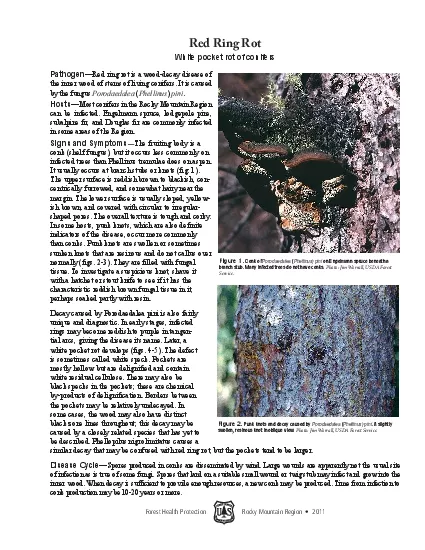

Red Ring RotWhite pocket rot of conifersPathogen151Red ring rot is a wooddecay disease of the inner wood of stems of living conifers It is caused by the fungus PorodaedaleaPhellinuspiniHosts151Most c ID: 860332
Download Pdf The PPT/PDF document "Forest Health Protection" is the property of its rightful owner. Permission is granted to download and print the materials on this web site for personal, non-commercial use only, and to display it on your personal computer provided you do not modify the materials and that you retain all copyright notices contained in the materials. By downloading content from our website, you accept the terms of this agreement.
1 Forest Health Protection Red Ring Rot Wh
Forest Health Protection Red Ring Rot White pocket rot of conifers Pathogen— Red ring rot is a wood-decay disease of the inner wood of stems of living conifers. It is caused by the fungus Porodaedalea ( Phellinus ) pini . Hosts— Most conifers in the Rocky Mountain Region can be infected. Engelmann spruce, lodgepole pine, subalpine �r, and Douglas �r are commonly infected in some areas of the Region. Signs and Symptoms — The fruiting body is a conk (shelf fungus), but it occurs less commonly on infected trees than Phellinus tremulae does on aspen. The upper surface is reddish brown to blackish, con - centrically furrowed, and somewhat hairy near the margin. The lower surface is usually sloped, yellow - ish brown, and covered with circular to irregular- shaped pores. The overall texture is tough and corky. indicators of the disease, occur more commonly than conks. Punk knots are swollen or sometimes sunken knots that are resinous and do not callus over normally (�gs. 2-3). They are �lled with fungal tissue. To investigate a suspicious knot, shave it with a hatchet or stout knife to see if it has the characteristic reddish brown fungal tissue in it, perhaps soaked partly with resin. unique and diagnostic. In early stages, infected - tial arcs, giving the disease its name. Later, a white pocket rot develops (�gs. 4-5). The defect is sometimes called white speck. Pockets are white residual cellulose. There may also be black specks in the pockets; these are chemical some cases, the wood may also have distinct black zone lines throughout; this decay may be caused by a closely related species that has yet to be described. Phellopilus nigrolimitatus causes a similar decay that may be confused with red ring rot, but the pockets tend to be larger. Disease Cycle— Spores produced in conks are disseminated by wind. Large wounds are apparently not the usual site of infection as is true of some fungi. Spores that land on a suitable small wound or twig stub may infect and grow into the Figure 1. Conk of Porodaedalea ( Phellinus) pini on Engelmann spruce beneath a branch stub. Many infected trees do not have conks. Photo: Jim Worrall, USDA Forest Figure 2. Punk knots and decay caused by Porodaedalea ( Phellinus) pini . A slightly swollen, resinous knot in oblique view. Photo: Jim Worrall, USDA Forest Service. Forest Health Protection Impact— Red ring rot is the most common decay in
2 Engelmann spruce and causes the large
Engelmann spruce and causes the largest decay columns. It is also important in lodgepole pine and is the second most important decay in subalpine �r. In a study of those three species, Porodaedalea pini caused 64% of all defect, including non-decay defects. It causes extensive cull, especially in old stands. Decay may extend 4 ft (1.2 m) above and 5 ft (1.5 m) below conks or punk knots. Decay tends to occur in the lower stem and may even develop into the large roots. It is not restricted to the heartwood ward into the sapwood. It sometimes leads to mechanical failure of live trees, causing hazard in recreation sites. animals. Although most cavity nesting by birds in this Region is ap - parently in aspen, various animals may take advantage of advanced decay to excavate the inner wood. Old dead and downed trees may outside-in and often do not provide such habitat. Management— Where emphasis is on timber management, trees with indicators should be removed during any entry. Indicators and the amount of decay and cull associated with them were studied in refs. 1 and 2. Besides conks and punk knots, indicators include forks and dead rust brooms. If decay is frequent, consider reducing rotation age to minimize losses. Prevent injuries to trees during logging to prevent new infections of decay fungi. Hi nds, T.E.; Hawksworth, F.G. 1966. Indicators and associated decay of Engelmann spruce in Colorado. Res. Pap. RM-25. Fort Collins, CO: U.S. Department of Agriculture, Forest Service, Rocky Mountain Forest and Range Experiment Station. . Hornibook, E.M. 1950. Estimating defect in mature and over-mature stands of three Rocky Mountain conifers. Journal of . Worrall, J.J.; Nakasone, K.K. 2009. Decays of Engelmann spruce and subalpine �r in the Rocky Mountains. Forest Insect and Disease Lea�et 150. Washington, DC: U.S. Department of Agriculture, Forest Service. 12 Figure 5. Very advanced white pocket rot of Porodaedalea ( Phellinus) pini with black zone lines. Photo: Jim Worrall, USDA Forest Service. Red Ring Rot - page 2 Figure 3. Front view of punk knot of Porodaedalea ( Phelli - nus) pini after shaving, revealing resin and reddish, golden brown fungal tissue that has replaced the branch trace. Photo: Jim Worrall, USDA Forest Service. Figure 4. Typical white pocket rot of Porodae - dalea ( Phellinus) pini with white pockets bordered by reddish, relatively undecayed wood. Photo: Jim Worrall, USDA Forest Service.